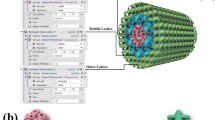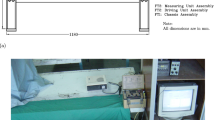Abstract
The strength of cylindrical butt joints, fabricated by bonding either aluminum or steel adherends together with an epoxy adhesive, has been determined for a wide range of bond thicknesses. Joint strength varied significantly with bond thickness. The measured strength of joints with steel adherends varied as the inverse cube root of bond thickness, while the strength of joints with aluminum adherends varied as the inverse fourth root of bond thickness. This bond thickness dependence is accurately predicted by an analysis that assumes failure occurs at a critical value of the interface corner stress intensity factor. The difference in the measured joint strength-bond thickness relation for joints with aluminum and steel adherends is a consequence of the difference in the order of the interface corner stress singularity.
Similar content being viewed by others
References
Adams, R.D. and Wake, W.C. (1984). Structural Adhesive Joints in Engineering. Elsevier Applied Science Publishers, London and New York.
Anderson, G.P. and DeVries, K.L. (1989). Predicting strength of adhesive joints from test results. International Journal of Fracture 39, 191–200.
Anderson, G.P., DeVries, K.L. and Sharon, G. (1985). Evaluation of tensile tests for adhesive bonds. In Delamination and Debonding of Materials, ASTM STP 876. (Edited by W.S. Johnson), American Society for Testing and Materials, Philadelphia 115–134.
Bogy, D.B. (1968). Edge-bonded dissimilar orthogonal elastic wedges under normal and shear loading. Journal of Applied Mechanics 35, 460–466.
Bogy, D.B. (1970). On the problem of edge-bonded elastic quarter-planes loaded at the boundary. International Journal of Solids and Structures 6, 1287–1313.
Chen, D.H. (1994). Analysis of singular stress field around the inclusion corner tip. Engineering Fracture Mechanics 49, 533–546.
Ding, S., Meekisho, L. and Kumosa, M. (1994). Analysis of stress singular fields at a bimaterial wedge corner. Engineering Fracture Mechanics 49, 569–585.
Dundurs, J. (1969). Discussion of edge-bonded dissimilar orthogonal elastic wedges under normal and shear loading. Journal of Applied Mechanics 36, 650–652.
Gradin, P.A. (1982). A fracture criterion for edge-bonded bimaterial bodies. Journal of Composite Materials 16, 448–456.
Groth, H.L. (1988). Stress singularities and fracture at interface corners in bonded joints. International Journal of Adhesion and Adhesives 8, 107–113.
Hattori, T., Sakata, S. and Murakami, G. (1989). A stress singularity parameter approach for evaluating the interfacial reliability of plastic encapsulated LSI devices. Journal of Electronic Packaging 111, 243–248.
Koguchi, H., Inoue, T. and Yada, T. (1996). Stress singularity in three-phase bonded structure. Journal of Applied Mechanics 63, 252–258.
Munz, D. and Yang, Y.Y. (1992). Stress singularities at the interface in bonded dissimilar materials under mechanical and thermal loading. Journal of Applied Mechanics 59, 857–861.
Pageau, S.S. and Biggers, Jr. S.B. (1995). Finite element evaluation of free-edge singular stress fields in anisotropic materials. International Journal for Numerical Methods in Engineering 38, 2225–2239.
Pageau, S.S., Joseph, P.F. and Biggers, Jr., S.B. (1995). Finite element analysis of anisotropic materials with singular inplane stress fields. International Journal of Solids and Structures 32, 571–591.
Reedy, Jr., E.D. (1990). Intensity of the stress singularity at the interface corner between a bonded elastic and rigid layer. Engineering Fracture Mechanics 36, 575–583.
Reedy, Jr., E.D. (1993). Asymptotic interface corner solutions for butt tensile joints. International Journal of Solids and Structures 30, (1993) 767–777.
Reedy, Jr., E.D. and Guess, T.R. (1993). Comparison of butt tensile strength data with interface corner stress intensity factor prediction. International Journal of Solids and Structures 30, 2929–2936.
Reedy, Jr., E.D. and Guess, T.R. (1995). Butt joint tensile strength: interface corner stress intensity factor prediction. Journal of Adhesion Science and Technology 9, 237–251.
Reedy, Jr., E.D. and Guess, T.R. (1996a). Butt joint strength: effect of residual stress and stress relaxation. Journal of Adhesion Science and Technology 10, 33–45.
Reedy, Jr., E.D. and Guess, T.R. (1996b). Interface corner stress states: plasticity effects. International Journal of Fracture 81, 269–282.
Szabó, B.A. and Yosibash, Z. (1996). Numerical analysis of singularities in two dimensions. Part 2: computation of generalized flux/stress intensity factors. International Journal for Numerical Methods in Engineering 39, 409–434.
Williams, M.L. (1952). Stress singularities resulting from various boundary conditions in angular corners of plates in extension. Journal of Applied Mechanics 19, 526–528.
Author information
Authors and Affiliations
Rights and permissions
About this article
Cite this article
Reedy, E., Guess, T. Interface Corner Failure Analysis of Joint Strength: Effect of Adherend Stiffness. International Journal of Fracture 88, 305–314 (1997). https://doi.org/10.1023/A:1007436110715
Issue Date:
DOI: https://doi.org/10.1023/A:1007436110715




